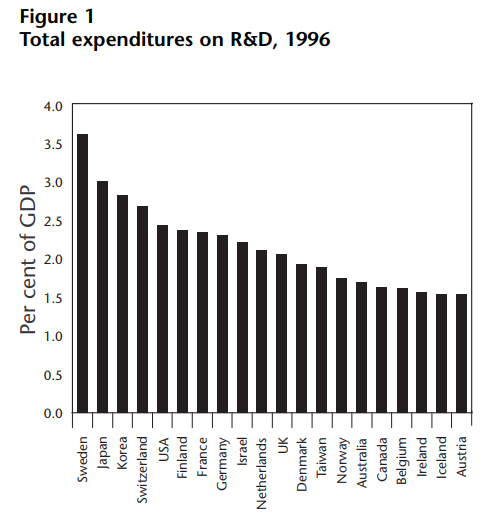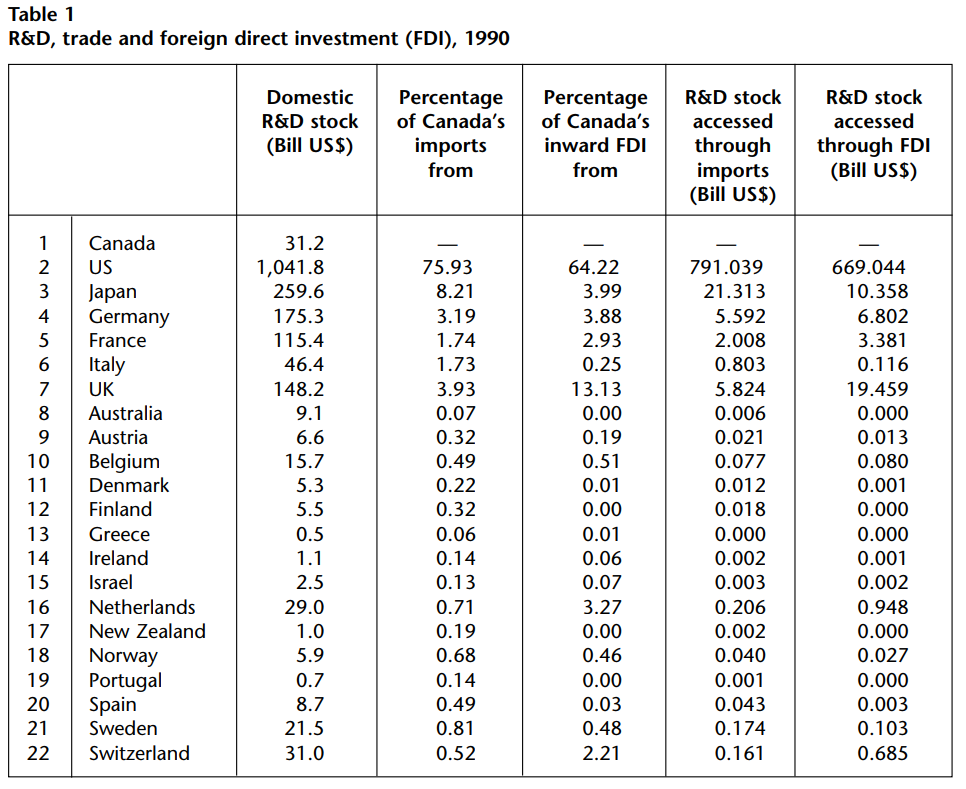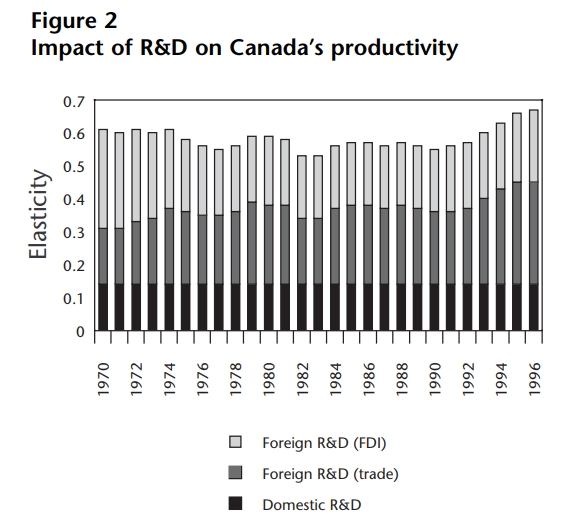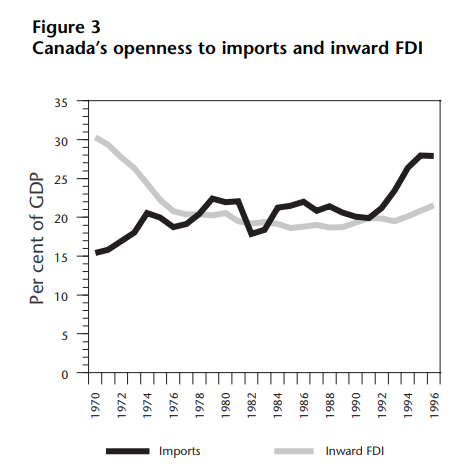
Economists have long known that the returns to research and development (R&D) are both private and social. The private returns accrue to the firm undertaking the R&D, mainly in the form of higher profits; the social returns add to the private returns any additional benefits that spill over to others. Research shows that the presence of significant spillover benefits normally cause social returns to far exceed private returns. Because private investors have no financial incentive to take these spillover benefits into account when making their investment decisions, in the absence of government intervention a free market will provide a less than socially optimal amount of R&D. This is the rationale for government subsidies for R&D spending, which have resulted in higher standards of living for all Canadians.
It has been argued, however, that Canada may be relying too heavily on its own domestic R&D efforts and not giving enough recognition to the importance of imported (or acquired) R&D. In effect, we pay for R&D to be undertaken domestically which could have been undertaken in other countries and which we could have benefited from simply by acquiring it—at much lower cost to ourselves. I want to argue, on the contrary, that while foreign R&D efforts have made a significant contribution to our economic well-being, we should not underestimate the importance of our own domestic efforts. We should therefore be concerned that Canada’s excessive reliance on acquired R&D at the expense of domestic R&D efforts has resulted in our falling last among G7 countries in terms of R&D expenditure as a share of GDP, and, as Figure 1 shows, even farther back when other non-G7 countries are included. In a recent survey we were 16th, between Belgium and Australia. This poor R&D performance is widely believed to be a leading cause of both the Canada-US productivity gap and the decline in the value of the Canadian dollar.
No one can deny that R&D creates out-of-country benefits. The whole world has benefited from technological development, even though, as the economists David Coe and Elhanan Helpman have reported, 96 per cent of the world’s stock of measured R&D is in the OECD countries, with 87 per cent in the G7 and slightly over 50 per cent in the US alone. There are several channels by which the acquisition of foreign R&D occurs: international trade, foreign direct investment (FDI), joint ventures, strategic alliances, technology licensing and labor mobility. In a recent study, A. E. Safarian and I tried to measure the impact of domestic and foreign R&D on productivity levels in OECD countries. Because data limitations prevented us from modeling all the channels by which technology diffusion takes place, our study focused on international trade and FDI as means by which OECD countries gain access to international pools of R&D. Our study looked at the entire OECD, but my focus here is on the Canadian case.
Many studies analyze the impact of flows of R&D expenditures on productivity. In contrast, here the focus is on stocks of R&D. We measure these stocks, which are meant to proxy for the stock of developed ideas and techniques at any point in time, by assuming they are the cumulative flows of each country’s past expenditures on R&D. Of course, some R&D efforts become obsolete and hence there must be some allowance for depreciation.
Given the existence of this international pool of R&D knowledge, the challenge is to identify how much of the foreign stock of R&D is accessible to Canadians. One could simply use the sum of all the domestic R&D stocks across the OECD countries and call this Canada’s stock of foreign R&D, but this would assume Canadians have exactly the same access to R&D undertaken in other countries as their domestic industries do. For example, it would assume that Canadian industries had exactly the same access to Japanese R&D efforts as Japanese industry, or exactly the same access to US R&D efforts as US industry. But they obviously don’t. So rather than assuming that the grand total of R&D done abroad is immediately available to Canada, we have to somehow weight the R&D efforts of other countries. We do this by looking at the different countries’ roles as trading partners with and investors in Canada.
When Canada imports goods and services from other countries, it also imports the technology embedded in these goods and services. Similarly, when multinational enterprises locate production facilities in Canada, they bring with them much in the way of technology, managerial know-how and other skills. In order to try to measure how much technology is embedded in Canada’s imports and also in Canada’s stock of inward FDI, we constructed the import-weighted and FDI-weighted R&D stocks of each of our trading partners. The inputs needed to calculate these foreign R&D stocks for 1990 are given in Table 1. For example, in that year Canada’s domestic stock of R&D amounted to US$31.2 billion, while the United States’ domestic R&D stock was US$1.041 trillion, followed by Japan at US$259.6 billion, and Germany at US$175.3 billion. The sum of the R&D stocks across all the OECD countries listed was US$1.93 trillion in 1990. In addition, Table 1 (page 44) provides the distribution of Canadian imports and inward FDI that originate in each OECD country. For example, in 1990, 75.9 per cent of Canada’s imports and 64.2 per cent of inward FDI came from the US. Similarly, 8.2 per cent of Canada’s imports and 4.0 per cent of inward FDI came from Japan.
Two features of Table 1 should be highlighted. The first relates to the importance of the US in terms of R&D spending: the stock of US R&D represents 53 per cent of the total R&D stock for all countries listed. The second relates to the diversity of Canada’s inward FDI as compared to its imports: although 75.9 per cent of Canada’s imports come from the US, only 64.2 per cent of Canada’s inward FDI does. By contrast, the UK is the source of only 3.9 per cent of Canada’s imports but 13.1 per cent of Canada’s inward FDI, while the Netherlands is the source of only 0.71 per cent of Canada’s imports but 3.27 per cent of Canada’s stock of inward FDI.
The R&D embedded in Canada’s imports we define to be the percentage of our total imports that come from the US multiplied by the US domestic R&D stock, plus the percentage of our total imports from Japan multiplied by the Japanese domestic R&D stock, and so on for all the OECD countries. The intuition behind this calculation is that, all else constant, the Canadian economy will achieve more international spillovers if it trades more with countries that have invested heavily in R&D.
We then extend the analysis to allow FDI to be an additional channel of R&D diffusion. The R&D embedded in Canada’s inward FDI stock is the following weighted average: the percentage of our total inward FDI stock from the US multiplied by the US domestic R&D stock, plus the percentage of our total inward FDI stock from Japan multiplied by the Japanese domestic R&D stock, and so on for all the OECD countries. The last two columns of Table 1 indicate the stock of R&D in each OECD country which Canada accesses via imports and inward FDI, respectively. Again, we see the dominance of the US.
By summing these columns, we calculate the amount of R&D contained in Canada’s imports as US$827 billion and Canada’s inward stocks of FDI as US$711 billion. When these are compared to Canada’s domestic R&D stock of US$31.2 billion, we see the importance of gaining access to such international pools of R&D. This underscores the importance of identifying and measuring the relative weight of alternate channels by which Canada can access these large international pools of knowledge.
Having calculated these foreign stocks of R&D for each year in our sample, we then use regression analysis to measure the independent impact that each of the three stocks of R&D has had on Canadian levels of total factor productivity. Regression analysis allows us to look for movements in Canadian productivity that are attributable to domestic R&D stocks, as well as to the R&D stocks embedded in Canada’s imports and Canada’s inward FDI. As a result, we are able to measure the importance of domestic and acquired R&D to the Canadian economy.
The calculations already made have shown us how large the various types of R&D are. But they don’t necessarily show how important they are to Canadian production. R&D that is not directly relevant to Canadian production, even if it is important in scale, would have a relatively small impact on Canadian productivity: very little movement in Canadian productivity levels might be attributed to this R&D. In contrast, R&D that is directly relevant to Canadian production would have a relatively large impact on Canadian productivity: even if it were not large in scale, a lot of movement in Canadian productivity levels will be attributed to this R&D. What regression analysis does is identify the movements in productivity that are systematically related to movements in R&D spending.
Our results are presented in Figure 2. It is important to point out that the measured impact of domestic R&D is constrained to be the same across years, which is a necessary condition of the statistical procedure used. That explains why the bottom vertical bar remains constant at 0.14 per cent throughout. In contrast, the impact of foreign R&D is allowed to vary over time. This is because in our regression analysis we interact the measured impact of R&D embedded in our imports with the level of Canada’s imports relative to GDP, and the measured impact of R&D embedded in our inward stock of FDI with the level of Canada’s inward FDI stock relative to GDP. Therefore, as the importance of imports relative to GDP varies, so too does the impact of the trade-related foreign R&D stock. The idea underlying this is that the more Canada imports, for a given set of import weights, the larger will be Canada’s foreign R&D stock, and hence the larger will be the impact on Canada’s productivity. Similarly, as inward FDI relative to GDP increases, for a given level of FDI weights, so too does Canada’s access to foreign R&D, and hence the larger the impact of the FDI-related foreign R&D stock.
The regression results presented in Figure 2 can be interpreted as follows. The vertical axis gives the measured (or estimated) impact of R&D on Canada’s productivity. The analysis is undertaken in such a way that the height of each bar is what we call an elasticity: it measures the percentage impact on productivity of a one-per cent increase in R&D. For example, the average height (impact) over the entire sample of the domestic R&D bar is 0.14. For R&D acquired through trade and through FDI, the average heights (impacts) are 0.24 and 0.21, respectively. These results indicate that increasing the domestic R&D stock by one per cent will increase Canada’s productivity by 0.14 per cent. Increasing the R&D embedded in Canada’s imports and Canada’s FDI by one per cent would increase Canada’s productivity by 0.24 per cent and 0.21 per cent, respectively. Of course, the impact of foreign R&D acquired by Canada through its trade and FDI is the sum of the two effects: 0.24 plus 0.21, which equals 0.45. Put differently, if each OECD country increased its domestic R&D stock by one per cent, there would be two impacts on Canada’s productivity: the direct impact that results from an increase in Canada’s own R&D stocks, which we estimate to be about 0.14 per cent, as well as the increase in Canada’s productivity that results because of access to the R&D undertaken in other countries, the measured impact of which we put at an additional 0.45 per cent. That is, Canada’s productivity would increase by 0.59 per cent (0.14 plus 0.45), and this increase in productivity would be permanent.
Two aspects of the results stand out. First, the impact of foreign R&D on Canada’s domestic productivity levels is three to five times larger than the domestic R&D impact. These results are consistent with those reported by Carleton University’s Jeffrey Bernstein in a 1996 study for Industry Canada which indicated that the social returns to R&D expenditure are up to 12 times the size of the private returns—with much of the social return in Canada being derived from spillover benefits of R&D undertaken in the US. A limitation of Bernstein’s results, however, is that they do not specify the channels by which R&D spills over. By contrast, our results identify separate spillovers occurring through international trade and foreign direct investment. Since Bernstein identifies the social impact of R&D (deriving mainly from international spillovers) to be up to 12 times larger than the private returns, and we find the international spillovers to R&D embedded in imports and inward FDI to be up to five times larger, we have identified channels that account for less than half of the possible spillovers. Therefore, we can infer that the additional channels of R&D diffusion not modeled due to data limitations are as important as the two we have modeled here.
A second noteworthy aspect of our results is that the relative importance of R&D entering Canada through FDI has been falling. This is not especially surprising, since FDI has become less important to Canada (as Figure 3 shows). The possible reasons for Canada’s declining shares of world, G7 and North American inward FDI stocks have generated substantial attention in Canadian policy circles and the impact on Canada’s productivity is but one dimension of that debate. On the other hand, imports into Canada have soared and the impact on Canada’s productivity of R&D embedded in Canada’s imports has also increased. In fact, the combined effect of trade and foreign investment is that the contribution of foreign R&D to Canada’s productivity growth is greater than at any time during the period studied, including the early 1970s, when high levels of foreign investment were an important political concern.
To return to the policy question posed at the outset: if Canadians can import all the R&D they need, should they nevertheless pay to subsidize domestic R&D expenditures? Those who believe Canada should depend on acquired R&D neglect two critical benefits derived from undertaking R&D domestically. The first relates to comparative advantage, and the second to who captures the returns to R&D.
International trade theory predicts that when countries open their economies to trade, each country will specialize in the production and export of the goods for which they have a comparative advantage. The acquired R&D that will be most applicable in Canadian production will originate in foreign countries that operate in the same industries as Canada, and hence in countries that compete with Canada internationally. If Canada were to leave R&D to these other countries, we would always lag behind our international competitors technologically. The lag involved in Canadian industries absorbing and implementing foreign technologies can be substantial. Moreover, without significant domestic R&D efforts, Canada’s ability to absorb foreign technologies, especially those of a more sophisticated nature, would be diminished, and this would further increase the lags involved in Canadian absorption of foreign technologies. Furthermore, nothing guarantees that foreign R&D efforts will coincide with those that are most appropriate in a Canadian setting. All in all, this would result in reduced competitiveness and a loss of market share for Canadian exporters. It is also worth noting that this conclusion holds whether we are dealing with trade between industries or trade within the same industry, although the cost of absorbing acquired R&D would likely be lower in the case of the latter.
The second reason for supporting domestic R&D is that although it has been established that foreign R&D spending improves productivity domestically, it is not clear who captures the gains from such R&D. For example, consider foreign direct investment in Canada. Both theory and empirical evidence indicate that such investments generally result in an improvement in the productivity with which resources are utilized in Canada. The results just reported reinforce this view. However, the evidence is less clear on who captures the returns: the multinational corporation or Canadians. Since corporations’ objectives are to maximize profits, it is likely that multinationals will use channels to enter foreign markets that allow them to capture as much of these gains as possible and hence increase profits. The domestic returns to acquired R&D may therefore be substantially lower than the returns that may be obtained had the R&D been undertaken domestically.
The results presented here are consistent with those of Roger Martin and Michael Porter in their recent study, Canadian Competitiveness: A Decade after the Crossroads, 2001. They argue that “Canadian firms and governments must turn their backs on a culture of replication, and strive instead for uniqueness and innovation,” and they go on to show that industries which depend upon replication are not globally competitive, whereas firms in industries which “act boldly and aggressively to innovate” are doing very well globally. Martin and Porter detail the performance of the Canadian newsprint industry as an example of the former kind of industry and the telecommunications switch industry as an example of the latter. Firms that pursue replication strategies depend mainly on acquired R&D, whereas firms that are innovative depend much more on their own R&D efforts.
To argue that Canada should not rely entirely on foreign or acquired R&D is not to say that we should undertake R&D in every industry. As countries become more globally oriented, they specialize in the goods for which they have a comparative advantage. It is in these industries in which R&D should be undertaken since R&D can be thought of as an additional part of the production process. But it is difficult if not impossible to determine ex ante which industries should or should not undertake R&D, and it is important that this decision not be left to government. There is no evidence that governments have a comparative advantage in analyzing comparative advantage.
The policy implications of the results presented here are clear. Government policy should encourage technology transfer, and an understanding of the relative importance of alternative channels of technology diffusion can improve this task. However, such attempts should not come at the expense of significant domestic R&D efforts, without which Canada’s productivity gap will continue to widen with our trading partners, particularly the US. Therefore, the government should subsidize R&D regardless of industry, and these subsidies must be increased to improve Canada’s R&D record. The alternatives to this option will be far too costly to Canadians.
Photo: Shutterstock












